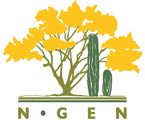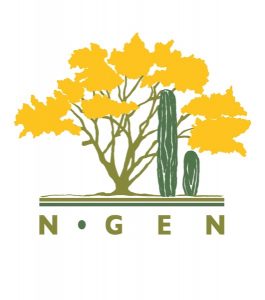Douglas R. Mitchell (1), Jonathan B. Mabry (2), Gary Huckleberry (2), Natalia Martínez Tagüeña (3), David L. Dettman (2)
1. Pueblo Grande Museum
2. University of Arizona
3. Instituto Potosino de Investigación Científica y Tecnológica
A group of U.S. and Mexican scientists specializing in archaeology, geology, botany, and paleoecology, we have been exploring prehistoric shell middens along the northern Gulf of California coast near the modern community of Puerto Peñasco, Sonora, Mexico (Figure 1). We have documented over 60 midden sites through reconnaissance survey near Puerto Peñasco since 1997. More recently, we have conducted controlled excavations and identified a variety of mollusc species, small fish bones, fish otoliths, crab claws, terrestrial animal bones, sea turtle bones, and artifacts.
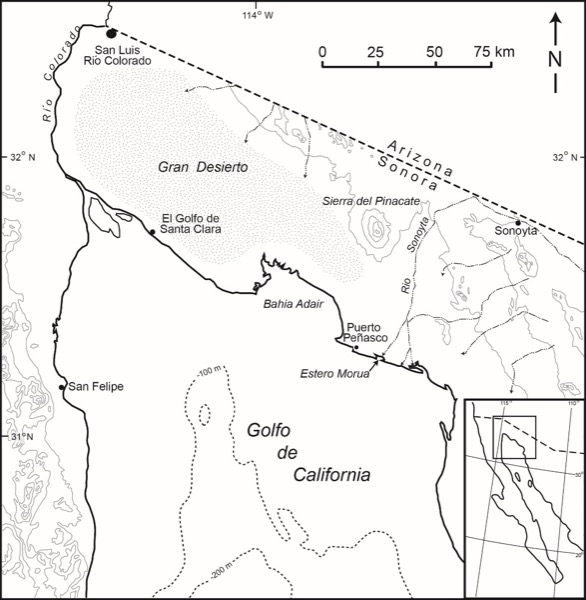
This project represents the first extensive and sustained archaeological investigations of prehistoric coastal adaptations in the Sonoran Desert, and the first research collaboration of U.S. and Mexican archaeologists and other researchers in this coastal region. Through this work, we hope to document material evidence of seasonal movements of diverse human groups across the present-day U.S.-Mexico border over the last 6,000 years coeval with changing coastal landforms and ecosystems.
Our project is trying to address several research issues through continued fieldwork and analyses in this area of the northern Gulf of California. Our project goals include research into the topics highlighted below.
We want to better understand the region’s paleoenvironmental history, particularly since the current tidal and estuary zones of the northern Gulf formed only about 6,000 years ago when global sea level stabilized after post-glacial rising, and some segments of the Sonoran coast near Bahia Adair have witnessed local sea level retreat in response to tectonic uplift. It is also important to look at subsistence strategies and food preferences of prehistoric fishing-foraging groups. Various indicators of seasonality point to coastal site occupations during the spring, fall, and winter. Analysis of the 18O contents of growth rings in mollusc shells, which respond strongly to the seasonal temperature cycle, can help refine models of the seasonality of shellfish collecting, and the seasonal availability of fresh water along the coast (springs and ephemeral streams).
We also are interested in better defining the cultural identity of prehistoric groups using this coastal area. Historically, this area was used by the Sand Papagos (also known as Areneños, or Hia Ced O’odham) and possibly the Pinacateños, which are groups within the Uto-Aztecan linguistic family. However, Cocopa groups speaking a Yuman dialect also visited the Puerto Peñasco area. Comcáac (Seri) oral history indicates that they visited this area and some groups lived there over extended periods of time in the past. Refinement of the dating of these various occupations is also important.
Interaction and exchange are important research topics for these sites. The prehistoric Hohokam culture of Arizona are well known for their use of marine shell, as were other ceramic period groups. The methods of shell collection for transport inland by ceramic and pre-ceramic groups needs to be further explored. We are trying to understand, mainly through an examination of the artifacts on the shell midden sites, which prehistoric groups created the middens and if they were collecting shell for manufacture into ornaments to trade with other groups.
An additional objective is to assess the impact of the economic development of the Puerto Peñasco area on the archaeological record of the region. The archaeological record in the Puerto Peñasco area is in grave danger of being destroyed due to development. A systematic, broad-scale effort to record, collect, and test sites is needed to document the extent and nature of prehistoric human activity in the region.
The Archaeology
We have surveyed, mapped, and excavated five shell midden sites thus far (Figure 2 and 3). One of the sites lies along a former channel of the Rio Sonoyta, near the Morua estuary, southeast of Puerto Peñasco. A recent radiocarbon date on shell midden charcoal suggests that this Rio Sonoyta channel was active as recently as the A.D. 1500s. The other four sites are located on the edge of Bahia Adair, to the north in an area of shifting dunes and recent tectonic uplift.
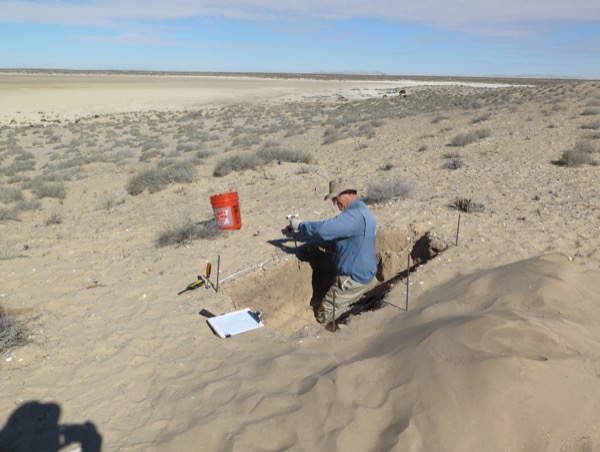
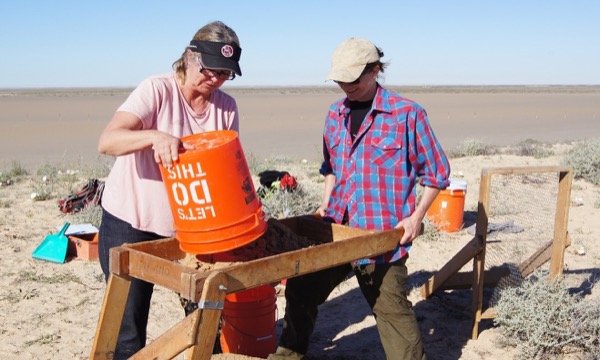
While excavating our test units, we collect, inventory, and weigh the shell according to species (Figure 4). We also collect samples for analysis of charcoal, fish bone, and animal bone. We have found evidence for buried midden layers (Figure 5) at several of the sites, dating as early as ca. 3700 B.C. Artifacts recovered from the midden sites include stone spear points, stone knives, grinding stones, and pottery fragments (Figure 6). Painted pottery can be associated with prehistoric groups from southern Arizona (Hohokam), southwestern Arizona (Patayan), and Mexico (Trincheras). It is possible these groups visited the area directly to collect shell and salt or local inhabitants may have traded these resources for pottery and agricultural foodstuffs. The types of artifacts found indicate use of these sites during the Archaic period through the ceramic period.
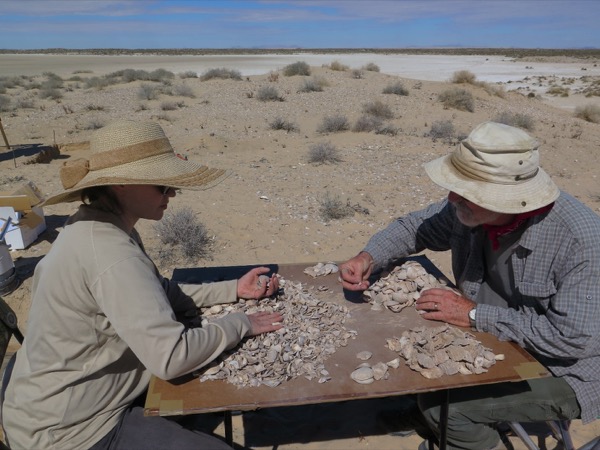
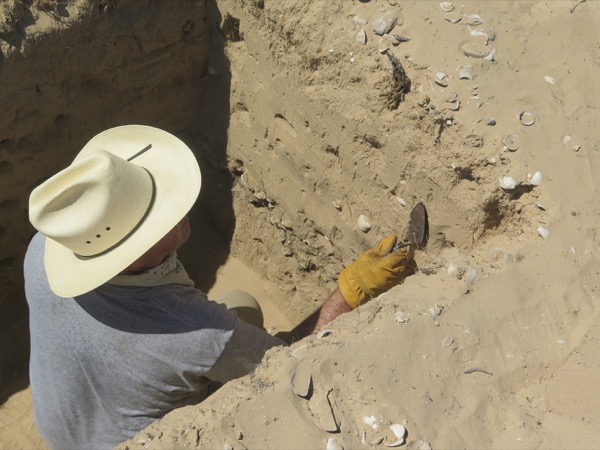
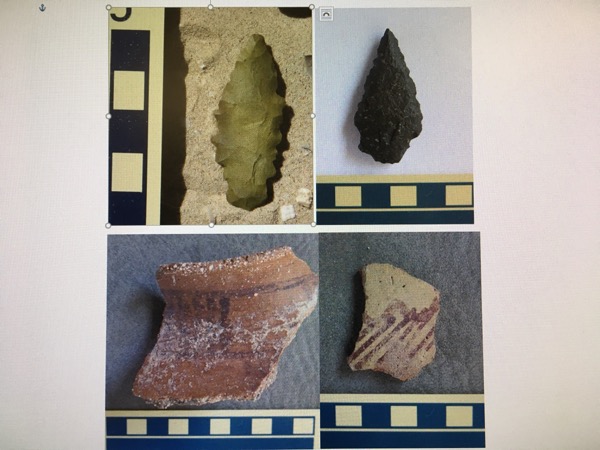
We have learned a great deal about the archaeology and paleoenvironment of this area. Our continued research in the Puerto Peñasco area has a great deal to contribute to our knowledge of Sonoran Desert archaeology, paleoenvironment, the interaction of prehistoric and historic groups, and adaptation to an arid coastal environment. Continued exploration will enhance our understanding of these important issues in the Sonoran Desert in both Mexico and the United States.
